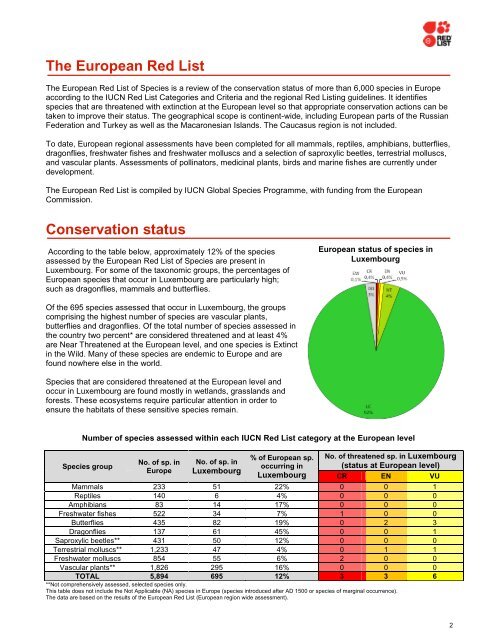Luxembourg's biodiversity at risk - IUCN
Luxembourg's biodiversity at risk - IUCN
Luxembourg's biodiversity at risk - IUCN
You also want an ePaper? Increase the reach of your titles
YUMPU automatically turns print PDFs into web optimized ePapers that Google loves.
The European Red List<br />
The European Red List of Species is a review of the conserv<strong>at</strong>ion st<strong>at</strong>us of more than 6,000 species in Europe<br />
according to the <strong>IUCN</strong> Red List C<strong>at</strong>egories and Criteria and the regional Red Listing guidelines. It identifies<br />
species th<strong>at</strong> are thre<strong>at</strong>ened with extinction <strong>at</strong> the European level so th<strong>at</strong> appropri<strong>at</strong>e conserv<strong>at</strong>ion actions can be<br />
taken to improve their st<strong>at</strong>us. The geographical scope is continent-wide, including European parts of the Russian<br />
Feder<strong>at</strong>ion and Turkey as well as the Macaronesian Islands. The Caucasus region is not included.<br />
To d<strong>at</strong>e, European regional assessments have been completed for all mammals, reptiles, amphibians, butterflies,<br />
dragonflies, freshw<strong>at</strong>er fishes and freshw<strong>at</strong>er molluscs and a selection of saproxylic beetles, terrestrial molluscs,<br />
and vascular plants. Assessments of pollin<strong>at</strong>ors, medicinal plants, birds and marine fishes are currently under<br />
development.<br />
The European Red List is compiled by <strong>IUCN</strong> Global Species Programme, with funding from the European<br />
Commission.<br />
Conserv<strong>at</strong>ion st<strong>at</strong>us<br />
According to the table below, approxim<strong>at</strong>ely 12% of the species<br />
assessed by the European Red List of Species are present in<br />
Luxembourg. For some of the taxonomic groups, the percentages of<br />
European species th<strong>at</strong> occur in Luxembourg are particularly high;<br />
such as dragonflies, mammals and butterflies.<br />
Of the 695 species assessed th<strong>at</strong> occur in Luxembourg, the groups<br />
comprising the highest number of species are vascular plants,<br />
butterflies and dragonflies. Of the total number of species assessed in<br />
the country two percent* are considered thre<strong>at</strong>ened and <strong>at</strong> least 4%<br />
are Near Thre<strong>at</strong>ened <strong>at</strong> the European level, and one species is Extinct<br />
in the Wild. Many of these species are endemic to Europe and are<br />
found nowhere else in the world.<br />
Species th<strong>at</strong> are considered thre<strong>at</strong>ened <strong>at</strong> the European level and<br />
occur in Luxembourg are found mostly in wetlands, grasslands and<br />
forests. These ecosystems require particular <strong>at</strong>tention in order to<br />
ensure the habit<strong>at</strong>s of these sensitive species remain.<br />
Species group<br />
No. of sp. in<br />
Europe<br />
No. of sp. in<br />
Luxembourg<br />
% of European sp.<br />
occurring in<br />
Luxembourg<br />
European st<strong>at</strong>us of species in<br />
Luxembourg<br />
Number of species assessed within each <strong>IUCN</strong> Red List c<strong>at</strong>egory <strong>at</strong> the European level<br />
No. of thre<strong>at</strong>ened sp. in Luxembourg<br />
(st<strong>at</strong>us <strong>at</strong> European level)<br />
CR EN VU<br />
Mammals 233 51 22% 0 0 1<br />
Reptiles 140 6 4% 0 0 0<br />
Amphibians 83 14 17% 0 0 0<br />
Freshw<strong>at</strong>er fishes 522 34 7% 1 0 0<br />
Butterflies 435 82 19% 0 2 3<br />
Dragonflies 137 61 45% 0 0 1<br />
Saproxylic beetles** 431 50 12% 0 0 0<br />
Terrestrial molluscs** 1,233 47 4% 0 1 1<br />
Freshw<strong>at</strong>er molluscs 854 55 6% 2 0 0<br />
Vascular plants** 1,826 295 16% 0 0 0<br />
TOTAL 5,894 695 12% 3 3 6<br />
**Not comprehensively assessed, selected species only.<br />
This table does not include the Not Applicable (NA) species in Europe (species introduced after AD 1500 or species of marginal occurrence).<br />
The d<strong>at</strong>a are based on the results of the European Red List (European region wide assessment).<br />
2
















